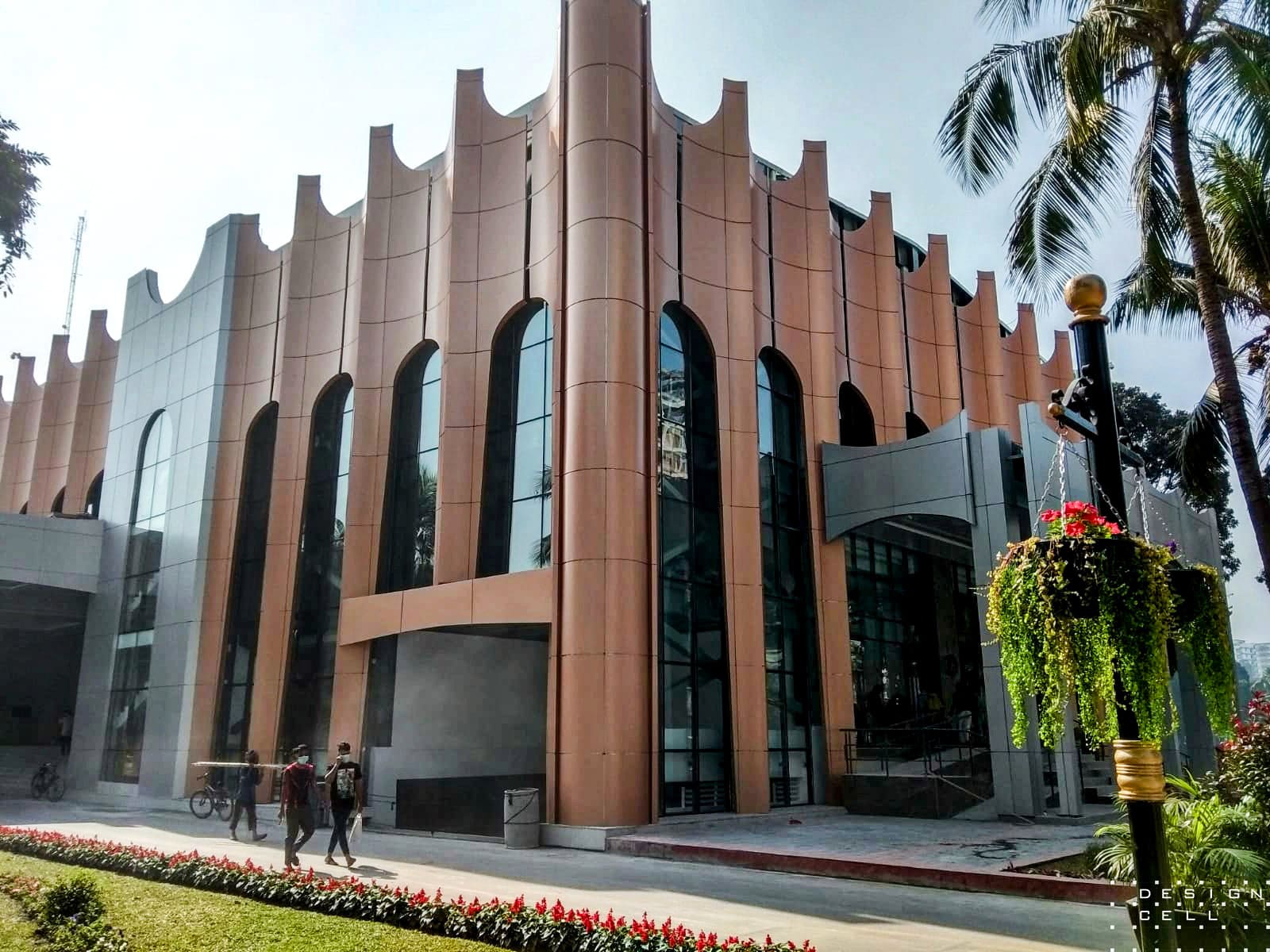Introduction
In modern architecture, the facade holds a pivotal role in shaping a building’s identity and character. It serves as the face of a structure, often defining its visual appeal and functionality. In recent years, the concept of facade design has undergone a remarkable transformation, evolving from a mere structural component to a dynamic canvas for architectural innovation and creativity. This transformation has been particularly evident in Bangladesh, where Dtech Corporation has emerged as a pioneering force in redefining architectural aesthetics through its innovative facade works. In this discourse, we delve into the essence of facade design, exploring its significance and the transformative impact it can bring to architectural landscapes, with a special focus on Dtech Corporation’s contributions in Bangladesh.
what is facade in architecture
A “facade” in architecture is the outer wall of a building, typically with doors or windows, especially the front one. Originally, facades were mainly for practical use, like support and weather protection, but now they’re also about looks, environment, and culture.
Aesthetic Appeal: Facades serve as the visual representation of a building’s design ethos and architectural style. They play a crucial role in shaping the overall aesthetic appeal of a structure, making it visually striking and memorable. With advancements in design technology and materials, architects now have unprecedented freedom to experiment with facade designs, ranging from sleek and minimalist to ornate and avant-garde.
Environmental Considerations: In an era marked by growing environmental awareness, facades play a vital role in enhancing a building’s sustainability and energy efficiency. Innovative facade solutions, such as green facades and solar panels, not only reduce carbon footprint but also contribute to improved indoor comfort and air quality.
Socio-Cultural Significance: Facades often reflect the cultural identity and values of a community or region. Architectural elements, such as motifs, colors, and materials, can evoke a sense of place and heritage, fostering a deeper connection between the built environment and its inhabitants.
facades serve as a canvas
Facades play a crucial role in defining the visual identity of a building and can significantly impact its overall aesthetic appeal. Here are some ways facades contribute to bringing a new look in architecture:
- Visual Impact: Facades serve as the primary interface between the building and its surroundings. A well-designed facade can create a striking visual impact, making the building stand out in its environment.
- Expression of Identity: Facades can reflect the identity, culture, and values associated with the building or its occupants. Whether it’s through the choice of materials, colors, or architectural elements, facades can convey a sense of place and purpose.
- Innovation in Materials: Advancements in materials technology have expanded the possibilities for facade design. From glass curtain walls to sustainable materials like recycled wood or metal, architects have a wide range of options to explore, allowing for innovative and unique facade solutions.
- Integration of Technology: Facades can incorporate various technological features such as smart glass, photovoltaic panels, or dynamic shading systems. These elements not only enhance the building’s functionality but also contribute to its visual appeal by adding a layer of sophistication and modernity.
- Sustainable Design: Sustainable facades are becoming increasingly popular as architects seek to minimize the environmental impact of buildings. Green facades, living walls, and passive design strategies can all contribute to energy efficiency, while also adding a distinctive look to the building.
- Adaptive Reuse: Facades can be creatively adapted or repurposed to give new life to existing structures. Adaptive reuse projects often preserve the historical or architectural significance of older buildings while introducing contemporary elements to refresh their appearance and functionality.
- Cultural Context: In regions with rich architectural traditions, facades can draw inspiration from local heritage and craftsmanship, creating a sense of continuity with the past while embracing contemporary design principles.
Types of Facade
Facades come in various types, each offering unique aesthetic, functional, and structural characteristics. Let’s explore some of the most common types of facades:
- Flat Facade: This type of facade features a simple, flat surface without any significant protrusions or recesses. It is characterized by clean lines and minimalist design, often used in modern and contemporary architecture. Flat facades are versatile and can be constructed using various materials such as glass, metal, or concrete panels.
- Curved Facade: Curved facades are designed with convex or concave curves, adding visual interest and dynamic appeal to a building’s exterior. These facades are often used in iconic landmarks and high-rise structures, where they create a sense of movement and fluidity. Curved facades require specialized engineering and construction techniques to achieve the desired curvature.
- Jamboo facade: Jambu Facade is a type of architectural design element, particularly in Indian architecture. “Jambu” refers to the vertical member on either side of a door or window frame. It can be purely decorative or serve a structural purpose. These facades are often intricately designed and can be found in various historical buildings across India, showcasing the craftsmanship and cultural aesthetics of the region.
- Stepped Facade: Also known as a “ziggurat” facade, this type features a series of horizontal steps or terraces that gradually recede or project from the building’s surface. Stepped facades create visual depth and dimensionality, breaking up the monotony of a flat surface. They are commonly found in modernist and brutalist architecture, where they serve both aesthetic and functional purposes.
- Glass Curtain Wall: A glass curtain wall facade consists of large glass panels held in place by metal or aluminum frames, creating a seamless and transparent envelope for the building. This type of facade maximizes natural light penetration and offers panoramic views of the surroundings. Glass curtain walls are popular in commercial and corporate buildings, where they convey a sense of openness and transparency.
- Ventilated Facade: Ventilated facades are designed with an air gap between the building’s exterior cladding and insulation layer, allowing for natural ventilation and thermal regulation. This type of facade helps improve energy efficiency and indoor comfort by reducing heat transfer and moisture buildup. Ventilated facades are often clad with materials such as ceramic tiles, metal panels, or fiber cement boards.
- Green Facade: Green facades, also known as living walls or vertical gardens, incorporate vegetation into the building’s exterior surface. Plants are grown on specially designed support structures, creating a lush and sustainable facade that improves air quality, reduces urban heat island effect, and enhances biodiversity. Green facades are popular in residential, commercial, and institutional buildings seeking to integrate nature into the built environment.
- Brick Facade: Brick facades utilize bricks as the primary cladding material, offering timeless appeal and enduring durability. Brick facades come in various styles and patterns, including running bond, stacked bond, and Flemish bond, allowing for creative expression and customization. Brick facades are prized for their aesthetic charm, structural integrity, and low maintenance requirements, making them a popular choice for residential and commercial buildings alike.
- Metal Mesh Facade: Metal mesh facades consist of interwoven metal wires or panels that form a semi-transparent screen over the building’s exterior. This type of facade offers solar shading, privacy, and security while allowing for natural ventilation and daylighting. Metal mesh facades are versatile and can be customized in terms of color, pattern, and transparency, adding a contemporary and industrial aesthetic to the building.
Evolution of facade design
The evolution of facade design has brought about a paradigm shift in the way we perceive and experience architecture. Beyond its functional and aesthetic dimensions, facade design has the power to transform urban landscapes, revitalize neighborhoods, and inspire social interaction. By pushing the boundaries of creativity and innovation, architects and developers can harness the transformative potential of facades to create iconic landmarks and sustainable urban environments.
Case Study: BGB Darbar Hall Project
The BGB Darbar Hall project is a monumental endeavor aimed at revitalizing and preserving one of the most culturally significant sites in Bangladesh. Located within the Bangladesh Garment Building (BGB) complex, the Darbar Hall holds immense historical and architectural value.
The project’s primary objective is to restore the Darbar Hall to its former glory while incorporating modern amenities and infrastructure to ensure its relevance for generations to come. This restoration effort encompasses meticulous attention to detail, including refurbishing intricate artworks, preserving original structural elements, and integrating state-of-the-art technology for enhanced functionality.
Beyond its architectural significance, the Darbar Hall project symbolizes a commitment to honoring Bangladesh’s rich heritage and fostering a deeper appreciation for its cultural legacy. Upon completion, the revitalized Darbar Hall will serve as a beacon of cultural pride and a vibrant hub for artistic expression, community gatherings, and educational initiatives.
As the curtains rise on the BGB Darbar Hall, may it serve as a symbol of pride for DTECH Corporation, showcasing not only your technical prowess but also your enduring commitment to shaping a better future through innovation.
Impact on Urban Fabric and Community Engagement
The transformation brought about by Dtech Corporation’s facade works extends beyond the realm of aesthetics. By reimagining the built environment, these projects have catalyzed urban renewal and economic development, breathing new life into neglected neighborhoods and public spaces. Moreover, the visually striking facades serve as catalysts for social interaction and community engagement, fostering a sense of pride and belonging among residents and visitors alike.
Challenges and Opportunities
Despite the immense potential of facade design to reshape architectural landscapes, several challenges persist. These include regulatory constraints, budgetary limitations, and the need for interdisciplinary collaboration. However, with proper planning, innovative thinking, and stakeholder engagement, these challenges can be overcome, paving the way for a more sustainable and visually appealing built environment.
Conclusion
In conclusion, the facade represents more than just the external face of a building—it embodies the aspirations, values, and identity of a community. Through innovative design, sustainable practices, and a deep understanding of local context, facade design has the power to transform architectural landscapes, redefine urban environments, and inspire social change. Dtech Corporation’s pioneering work in Bangladesh exemplifies this transformative potential, offering a glimpse into a future where architecture transcends mere utility to become a catalyst for positive change. As we continue to push the boundaries of creativity and innovation, let us embrace the transformative power of facade design to create a more beautiful, sustainable, and inclusive built environment for generations to come.


Leave a Reply